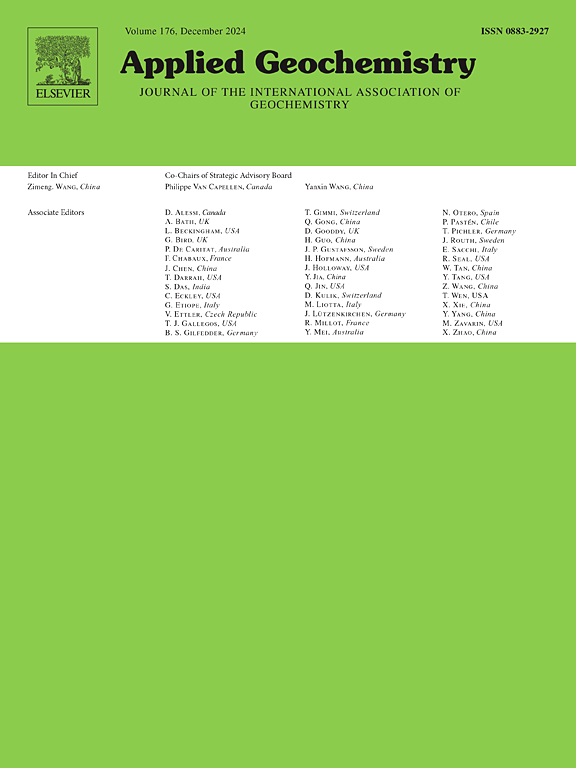CAFM: a freeware for geochemical data processing and concentration–area fractal modeling and its application for identifying uranium anomalies of different genesis
IF 3.4
3区 地球科学
Q1 GEOCHEMISTRY & GEOPHYSICS
引用次数: 0
Abstract
We present a freeware named CAFM, which is specifically designed for geochemical data interpolation, computation, and concentration-area (C-A) fractal modeling. Additionally, we propose a Fixed Scale Moving Average Error (FSMAE) method to achieve rapid and automatic classification of C-A fractal populations. This freeware has been successfully applied to identify U anomalies and distinguish their genesis based on surface concentrations of U, Th, and K derived from airborne gamma data. The Yingen area in the southeastern part of the Bayingobi Basin serves as the research focus of our study. In this area, we utilized the breakpoints between adjacent straight-line segments on Log-Log plots of C-A relationships for U, Th, and K to differentiate elemental populations. These separated datasets were subsequently analyzed using the C-A fractal method, and the results were compared with geological observations. The comparison reveals that U populations are highly effective in identifying U enrichment anomalies, particularly surface mineralization anomalies. In contrast, Th populations can indicate the presence of intrusive rocks and hydrothermal activities. However, K populations provide limited geological information due to their susceptibility to surface sediment influences. Furthermore, with the aid of CAFM, we proposed a U/Th bimetal index, which has been demonstrated to effectively distinguish between magmatic, hydrothermal, and sedimentary –hosted U enrichment anomalies. Utilizing this index, we discovered a new area with sedimentary-related U anomalies in the southeastern part of the Yingen area, highlighting its potential value for future exploration efforts. Our study has shown that integrating airborne gamma data with C-A fractal modeling can effectively identify U anomalies and determine their genesis. The CAFM software and the FSMAE method offer valuable tools for U exploration.
CAFM:地球化学数据处理和浓度-面积分形建模软件及其在不同成因铀异常识别中的应用
我们提出了一个名为CAFM的免费软件,它是专门为地球化学数据插值、计算和浓度-面积(C-A)分形建模而设计的。此外,我们提出了一种固定尺度移动平均误差(FSMAE)方法来实现C-A分形总体的快速自动分类。该免费软件已成功应用于识别U异常,并根据机载伽马数据得出的U、Th和K的表面浓度区分其成因。本研究以巴音郭壁盆地东南部英根地区为研究重点。在这个区域,我们利用U、Th和K的C-A关系的Log-Log图上相邻直线段之间的断点来区分元素种群。随后使用C-A分形方法对这些分离数据集进行分析,并将结果与地质观测结果进行比较。对比结果表明,铀种群对铀富集异常,特别是地表矿化异常的识别非常有效。相反,这些种群可以指示侵入岩和热液活动的存在。然而,由于K种群易受地表沉积物的影响,它们提供的地质信息有限。此外,借助CAFM,我们提出了U/Th双金属指数,该指数已被证明可以有效区分岩浆、热液和沉积型铀富集异常。利用该指标,在莺根地区东南部发现了一个新的与沉积有关的U异常区域,突出了该区域未来勘探的潜在价值。研究表明,将航空伽马数据与C-A分形模型相结合,可以有效地识别U异常并确定其成因。CAFM软件和FSMAE方法为U勘探提供了有价值的工具。
本文章由计算机程序翻译,如有差异,请以英文原文为准。
求助全文
约1分钟内获得全文
求助全文
来源期刊

Applied Geochemistry
地学-地球化学与地球物理
CiteScore
6.10
自引率
8.80%
发文量
272
审稿时长
65 days
期刊介绍:
Applied Geochemistry is an international journal devoted to publication of original research papers, rapid research communications and selected review papers in geochemistry and urban geochemistry which have some practical application to an aspect of human endeavour, such as the preservation of the environment, health, waste disposal and the search for resources. Papers on applications of inorganic, organic and isotope geochemistry and geochemical processes are therefore welcome provided they meet the main criterion. Spatial and temporal monitoring case studies are only of interest to our international readership if they present new ideas of broad application.
Topics covered include: (1) Environmental geochemistry (including natural and anthropogenic aspects, and protection and remediation strategies); (2) Hydrogeochemistry (surface and groundwater); (3) Medical (urban) geochemistry; (4) The search for energy resources (in particular unconventional oil and gas or emerging metal resources); (5) Energy exploitation (in particular geothermal energy and CCS); (6) Upgrading of energy and mineral resources where there is a direct geochemical application; and (7) Waste disposal, including nuclear waste disposal.
 求助内容:
求助内容: 应助结果提醒方式:
应助结果提醒方式:


